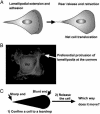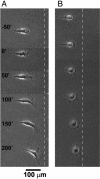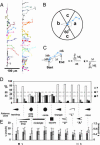Directing cell migration with asymmetric micropatterns
- PMID: 15653772
- PMCID: PMC545855
- DOI: 10.1073/pnas.0408954102
Directing cell migration with asymmetric micropatterns
Abstract
This report shows that the direction of polarization of attached mammalian cells determines the direction in which they move. Surfaces micropatterned with appropriately functionalized self-assembled monolayers constrain individual cells to asymmetric geometries (for example, a teardrop); these geometries polarize the morphology of the cell. After electrochemical desorption of the self-assembled monolayers removes these constraints and allows the cells to move across the surface, they move toward their blunt ends.
Figures




Similar articles
-
Steering cell migration using microarray amplification of natural directional persistence.Langmuir. 2011 Apr 5;27(7):3803-7. doi: 10.1021/la2000206. Epub 2011 Feb 28. Langmuir. 2011. PMID: 21355564 Free PMC article.
-
Regulation of collective cell polarity and migration using dynamically adhesive micropatterned substrates.Acta Biomater. 2021 May;126:291-300. doi: 10.1016/j.actbio.2021.03.032. Epub 2021 Mar 16. Acta Biomater. 2021. PMID: 33741539
-
Passive control of cell locomotion using micropatterns: the effect of micropattern geometry on the migratory behavior of adherent cells.Lab Chip. 2012 Jul 7;12(13):2391-402. doi: 10.1039/c2lc40084g. Epub 2012 Apr 25. Lab Chip. 2012. PMID: 22534829
-
Caveolin-1 in cell polarization and directional migration.Eur J Cell Biol. 2008 Sep;87(8-9):641-7. doi: 10.1016/j.ejcb.2008.02.001. Epub 2008 Mar 28. Eur J Cell Biol. 2008. PMID: 18375013 Review.
-
Insights into the mechanism for dictating polarity in migrating T-cells.Int Rev Cell Mol Biol. 2014;312:201-70. doi: 10.1016/B978-0-12-800178-3.00007-5. Int Rev Cell Mol Biol. 2014. PMID: 25262243 Review.
Cited by
-
Micropatterning different cell types with microarray amplification of natural directional persistence.Adv Healthc Mater. 2013 Feb;2(2):334-42. doi: 10.1002/adhm.201200141. Epub 2012 Sep 5. Adv Healthc Mater. 2013. PMID: 23184681 Free PMC article.
-
Paper-based in vitro tissue chip for delivering programmed mechanical stimuli of local compression and shear flow.J Biol Eng. 2020 Jul 28;14:20. doi: 10.1186/s13036-020-00242-5. eCollection 2020. J Biol Eng. 2020. PMID: 32742306 Free PMC article.
-
Geometric cues for directing the differentiation of mesenchymal stem cells.Proc Natl Acad Sci U S A. 2010 Mar 16;107(11):4872-7. doi: 10.1073/pnas.0903269107. Epub 2010 Mar 1. Proc Natl Acad Sci U S A. 2010. PMID: 20194780 Free PMC article.
-
Feedback mechanisms in a mechanical model of cell polarization.Phys Biol. 2014 Oct 14;11(6):066002. doi: 10.1088/1478-3975/11/6/066002. Phys Biol. 2014. PMID: 25313164 Free PMC article.
-
Cellular and multicellular form and function.Adv Drug Deliv Rev. 2007 Nov 10;59(13):1319-28. doi: 10.1016/j.addr.2007.08.011. Epub 2007 Aug 16. Adv Drug Deliv Rev. 2007. PMID: 17884241 Free PMC article. Review.
References
-
- Alberts, B., Johnson, A., Lewis, J., Raff, M., Keith, R. & Walter, P. (2002) Molecular Biology of the Cell (Garland, New York).
-
- Lauffenburger, D. A. & Horwitz, A. F. (1996) Cell 84, 359–369. - PubMed
-
- Whitesides, G. M., Ostuni, E., Takayama, S., Jiang, X. & Ingber, D. E. (2001) Ann. Rev. Biomed. Eng. 3, 335–373. - PubMed
-
- Jiang, X., Ferrigno, R., Mrksich, M. & Whitesides, G. M. (2003) J. Am. Chem. Soc. 125, 2366–2367. - PubMed
-
- Verkhovsky, A. B., Svitkina, T. M. & Borisy, G. G. (1999) Curr. Biol. 9, 11–20. - PubMed
Publication types
MeSH terms
Grants and funding
LinkOut - more resources
Full Text Sources
Other Literature Sources
Molecular Biology Databases

